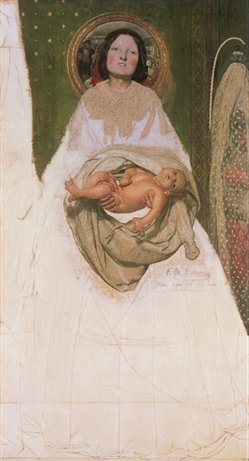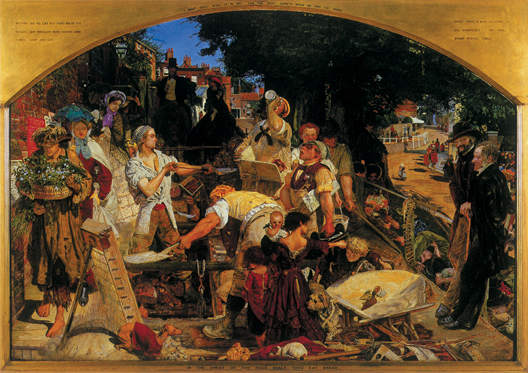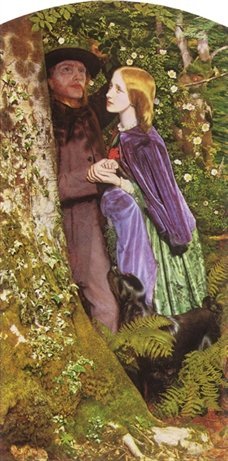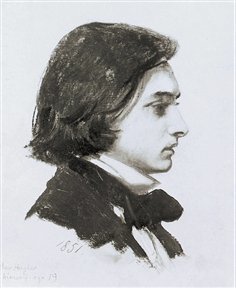Dante Gabriel Rossetti,
Ford Madox Brown, 1852.
Pencil, 17.1 x 11.4 cm.
National Portrait Gallery, London.
Ford Madox Brown
(Calais, 1821 - London, 1893)
Ford Madox Brown’s father was a retired navy purser and his mother’s family came from Kent. His paternal grandfather was the Scottish doctor John Brown, who established the “Bruonian” theory of medicine. Ford Madox Brown had no brothers or sisters. He spent his youth shuttling between England and the Continent, and at the age of six showed a strong inclination for drawing and painting. In 1835 he took classes at Bruges from a student of David, Gregorius, but the fundamental part of his education began in 1837, under Baron Wappers, who was considered a great authority in Antwerp. From his earliest years, Brown showed remarkable strength in drawing and painting, as evidenced by a portrait of his father, completed when the boy was fourteen years old. Orphaned at nineteen, Brown lived modestly but nonetheless travelled around Europe. In 1841 he married his cousin Elizabeth Bomley and left for London in 1844. Then in 1845-1846 he explored Rome, where he admired the work of the Nazarenes, a small group of nineteenth-century young German painters who held the opinion that art should serve a moral or religious purpose. They also advocated a return to the spirit of the Middle Ages.
In 1846 Brown moved to London where his wife succumbed to tuberculosis, leaving one daughter, Lucy, who married William M. Rossetti in 1874. After a short time as a widower, Brown took Emma Hill as his second wife. She posed for many of his paintings. In 1848 Brown was contacted by Rossetti and agreed to give him lessons. Through Rossetti, Brown became associated with the Pre-Raphaelite movement. He shared some of their principles, such as that of remaining true to nature, and though he was sometimes considered to be their inspiration, he refused to join the group. Brown’s art is characterised by profoundly theatrical historic scenes and reinforced by a meticulous attention to detail. For example, in his painting Chaucer at the Court of Edward III, begun in Rome in 1845 and completed in London in 1848, one can spot in the crowd certain members of the Pre-Raphaelite Brotherhood. Landscapes like An English Autumn Afternoon, demonstrate this. At the beginning of his career, he simply used landscapes as backgrounds, as the Pre-Raphaelites did, but he later painted them for their own merit. In his landscapes, nature is not glorified but described as it is, and Ruskin reproached him for this. Brown also had a passion for contemporary subjects; “Take your Son, Sir” he addresses the same theme of prostitution as Rossetti did in Found. In Work, he treats the subject of the new industrialised society and glorifies the progress of modern England. Finally, in The Last of England, he explores the economic emigration that he himself considered when his career was at a low point. This painting was inspired by the departure of the Pre-Raphaelite sculptor Thomas Woolner. In 1865, independently of the Royal Academy, he organised an exhibition of his works in London around Work. Besides his work as a painter, Brown also created designs for stained glass, and until 1874 he was a member of Morris, Marshall, Faulkner and Co., a design firm founded by William Morris. He also painted many portraits and even self-portraits, and he occasionally gave lectures. In 1878, he devoted himself to decorating Manchester City Hall.
Brown was never a highly remunerated or popular artist. For half his life he had difficulties with money, and even when his situation improved he was never truly well off. Though as a young man he seemed to have a certain future as a successful painter, his life took another direction after some disappointments and difficulties. From 1868 he suffered from gout, and he died after an attack of apoplexy.

Ford Madox Brown,
“Take your son, sir”, c. 1851-1892.
Oil on canvas, 70.5 x 38.1 cm.
Tate Britain, London.

Ford Madox Brown,
Work, 1852-1865.
Oil on canvas, 137 x 197.3 cm.
Manchester Art Gallery, Manchester.

Arthur Hughes,
The Long Engagement, 1859.
Oil on canvas, 107 x 53.3 cm.
Birmingham Museums and Art Gallery, Birmingham.

Arthur Hughes, Self-Portrait, 1851.
Private Collection.
Arthur Hughes
(London, 1832 - Kew, 1915)
Arthur Hughes was the third and final son of Edward and Amy Hughes. In 1838 he entered Archbishop Tenison’s Grammar School, and it was in this establishment that he took his first steps in drawing. At fourteen, he entered the School of Design at Somerset House in London where he studied under Alfred Stevens, a Belgian painter close to the Impressionists. He was accepted the following year, in 1847, at the Antique School of the Royal Academy, where he won several prizes. In 1849, his painting Musidora was exhibited at the Academy.
In 1850, while he was a third-year student at the Royal Academy, he discovered Pre-Raphaelitism by reading all four issues of the periodical The Germ, and was immediately enthused. He began painting according to Pre-Raphaelite principles. He was particularly interested in their desire to remain true to nature and their love of literature. Like them, he enjoyed the poems of John Keats and Tennyson, whose verses he later illustrated. He met Rossetti, Brown, Hunt and the sculptor Alexander Munro, and adopted their ideals. He also met the woman who would become his wife, Tryphena Foord.
In 1852 he met Millais and exhibited his first painting created according to Pre-Raphaelite principles: Ophelia. This painting depicts Ophelia a few moments before her death, unlike that of Millais where we see her floating at the surface of the water. The first time it was exhibited, the painting was hung in an inconspicuous location, but Millais noticed and appreciated it. The next year, Hughes began a painting entitled Orlando in the Forest of Arden, in which he paid particular attention to the background. However, the painting was not chosen by the Royal Academy in 1855. Not letting himself be discouraged, Hughes replaced the figure of Orlando with a man and woman promising one another eternal love. In this form, the painting was accepted and exhibited in 1859.
In November 1855, he married Tryphena Foord at Holy Trinity Church in Maidstone, and they later had five children. She posed as a model for many of his paintings, including April Love in 1855-1856. This painting earned him the praise of Ruskin, who particularly appreciated the detailed vegetation. It was purchased by William Morris, who then presented it to Edward Burne-Jones.
In 1855 Hughes began a career as an illustrator and worked with George MacDonald. In 1856 he painted The Eve of Saint Agnes, inspired by John Keats’ 1820 poem. Like his Ophelia of 1852, this triptych painting is surrounded by a golden frame engraved with verses from the poem that inspired it.